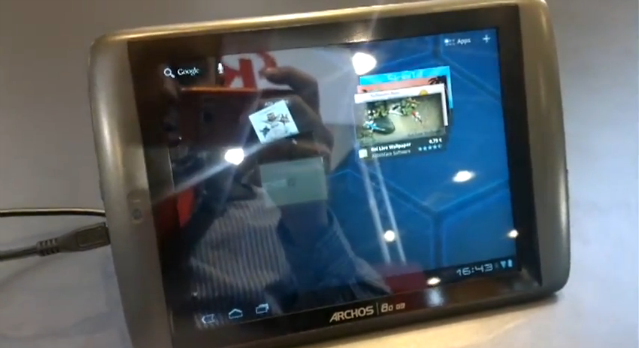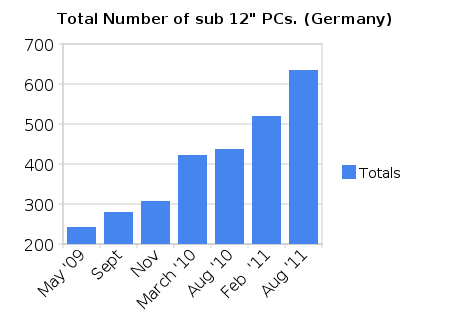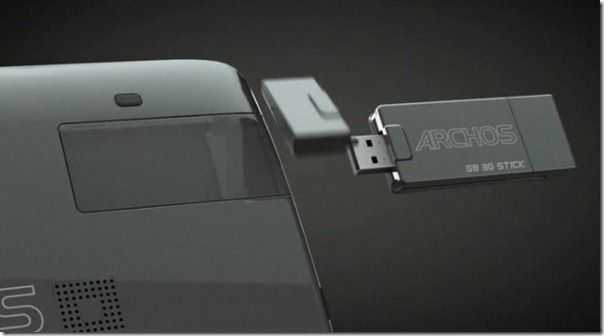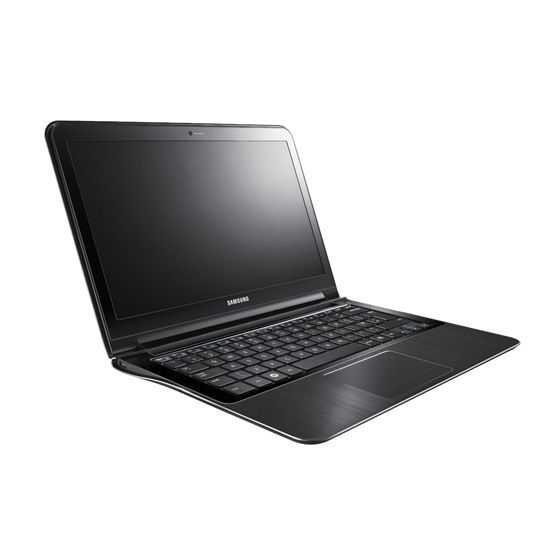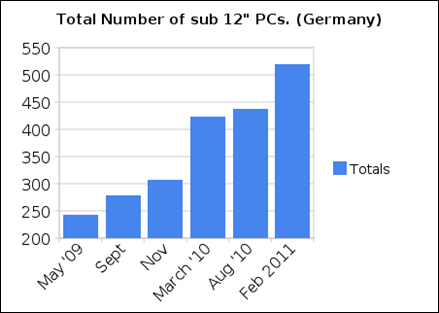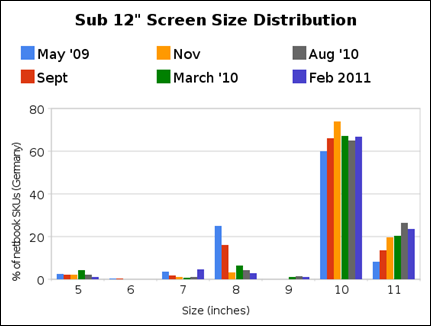Hands-on with the Archos 80 G9 [specs sheet]. Overview of Archos’ new G9 tablets here.
Tag Archive | "archos"
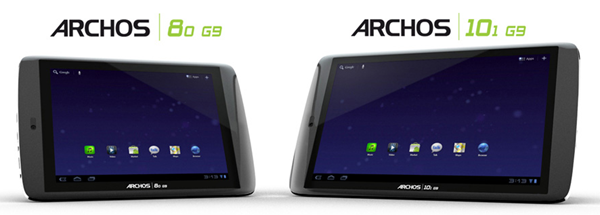
Lowest Capacity Archos G9 Tablets Will be Slower Than Others, But Why? (also, EU pricing confirmed)
Posted on 02 September 2011
 We’re really looking forward to Archos’ new G9 tablets, their inexpensive price and unique features are going make them a welcomed addition to the world of Honeycomb tablets.
We’re really looking forward to Archos’ new G9 tablets, their inexpensive price and unique features are going make them a welcomed addition to the world of Honeycomb tablets.
As Charbax of ARMdevices.net shows us, the TI OMAP 4460 found in the G9 tablets will run at different speeds depending upon the capacity (and the price) of the tablet that you purchase.
When Archos first announced the Archos 80 G9 and the 101 G9, they were said to eventually be available in 8/16/250GB capacities, while other specs would remain the same. However, at IDF they are now showing that the 8GB variant of both models will run at 1GHz instead of 1.5GHz.
The lower capacity makes sense to bring down the price even further and offer additional choice to customers. What I don’t quite understand is the lower clock speed. As far as I can tell, the 8GB model of the 80 and 101 is still running the same CPU as the 16/250GB models. Feel free to correct me on this, but I can’t think of any additional fee that would be incurred to use a different clock speed on the CPU, so I have to wonder why they are lowering the speed on the 8GB variants.
My best theory is that Archos wants the more expensive models to be the most appealing, and give an additional incentive for going with one of the higher capacity units. If that’s the case, I can’t help but feel like they’re artificially giving users of the 8GB variants the shaft, though I’m hoping there is something less dubious behind it.
Archos confirmed US pricing for the 16GB variants of the 80 and 101 back when they were first announced; $270 and $349 respectively, and we should see the other models officially priced soon. Charbax has the official EU prices for all models here. The G9 80 and 101 will become available at the end of September, according to Archos.
Chippy is on the IDF show floor and we’ll see if he can get this question about the CPU speed answered for us.
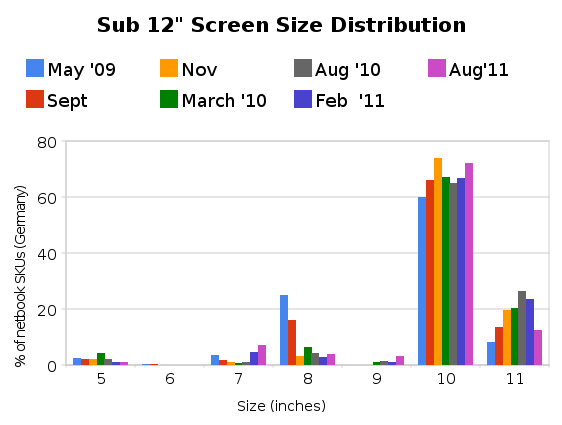
Screen Size Analysis (Sub 12″) August 2011
Posted on 24 August 2011
This is the seventh report on sizing trends in PCs below 12 inch screen size (and above 5 inch) appearing in the German market through the popular price comparison engine, Geizhals.at (*1) The last one was done in Feb 2011. Once again we’ve seen a big jump in overall numbers. The 7″ segment and 10″ segment have grown while the 11″ segment has shrunk. The 10″ market dominates more in this report than it did in the report of Feb 2011 although there is a clear trend occurring in the 7″ space where growth in products has occurred in all of the last 4 reports.
Number of SKUs in the market
The number of choices in the mobile screen space (above smartphones) has grown over 2x from approx 240 SKUs to over 630 SKUs.
Screen size distribution
The big jump in numbers is clear to see from the top graph. Total numbers jumped by 115 with most of that growth coming from the tablet form factor and the 10″ netbook/notebook sector. Big increases in the 7″ tablet sector (now the biggest number so far) and a reduction in the numbers of 11″ devices mean that percentage distribution has changed a lot. The iPad2 introduction caused the growth in the 9″ segment.
In the 10″ netbook space which accounts for 75% of the 10″ category there are now 18 AMD C-Series SKUs and 315 Atom SKUs. 64 of the Atom-based devices (20%) use the high-end N570 version.
In interesting statistic is that 1 in 5 devices on the market in the 5-11″ segment are from ASUS.
Across all categories, ARM-based CPU designs account for 23% of all devices, almost exclusively in the tablet sector. It will be interesting to see how that changes over the next 2 years with the introduction of Windows for the ARM processor.
In terms of weight, the tablets mean that the average weight of a device has gone down. 28% of the devices weigh under 1KG.
Meego appears for the first time along with the cheapest and lightest netbook ever launched. The ASUS Eee PC X101.
Chromebooks did not enter the sub 12″ screen space yet. (Acer 700 not available in Germany)
Sandy Bridge (2nd Generation Intel Core CPUs) enters the sector with 14 SKUs from 5 devices.
Total number of tablet form-factor devices: 193 (30% of total)
Cheapest devices:
- X86/Windows Laptop Eee PCR101D at 199 Euros. (Was: Samsung N145 at 228 Euro)
- Non-Windows Laptop (X86-CPU) – Eee PC X101 (Meego) at 169 Euros
- ARM Tablet Debitel One Pad (Android 1.5) at 59 Euro
- X86/Windows Tablet Archos 9 at 370 Euros (was 402 Euros)
In terms of netbook trends, the search and news volumes seem to be steady after their large drop in Q1 (see Google Trends.) Numbers of devices in the market have increased and obviously the introduction of Cedar Trail in Q4 will create news, products and searches in the netbook category. The trend for netbook products, news and search is going to be level-to-rising for Q4 That may, or may not, relate to sales numbers.
In terms of handheld PCs, our focus here at UMPCPortal, it’s a sad story. The online market is now almost totally clear of 5-9″ X86-based Windows devices. It will be interesting to see how the Windows 8 market affects this in 2012.
Warning: Please remember that this is a single data-source analysis of what is happenning today, in the German market. This is not a complete market analysis report. You may use the data and images but please also reference this article which includes this warning.
*1 Based on SKUs, not model families. Data taken from Geizhals An English language (and UK market) version of Geizhals is available at Skinflint.
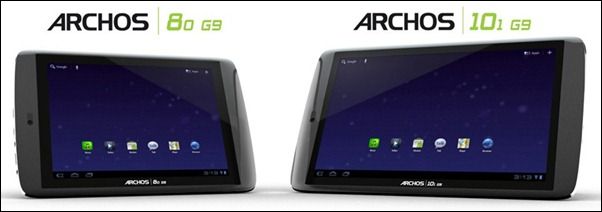
Archos Gen 9 Tablets Now Tracking in the Product Database
Posted on 27 July 2011
 We’ve just finished adding the recently announced Archos 80 G9 and the 101 G9 to our mobile product database where you can find official specifications, popularity charts, links, photos, and more. Have a look here:
We’ve just finished adding the recently announced Archos 80 G9 and the 101 G9 to our mobile product database where you can find official specifications, popularity charts, links, photos, and more. Have a look here:
We’ll be keeping a close eye on these exciting upcoming devices along with plenty of others. You can browse through our entire database here, which features hundreds of mobile devices!
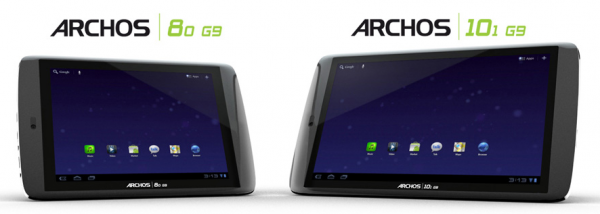
Archos Announces Two Unique Tablets — Honeycomb, 250GB HDD Option, Modular 3G, Well Priced [video]
Posted on 20 July 2011
Archos has unveiled two “bang for bucks inch Android Honeycomb tablets: the 8-inch (1024×768, 4:3) ’80 G9′ and the 10.1-inch (1280×800, 1.6:1) ‘101 G9’.
The 80 and the 101 both use a dual-core TI OMAP 4460 processor running at 1.5GHz. With more grunt under the hood than most Tegra 2-powered Android tablets in the market these days, the tablet looks promising to deliver a silky smooth multitasking experience as well as high resolution video playback. Archos claims that the OMAP 4460 CPU is up to 50% faster than Nvidia’s Tegra 2 in certain situations.
As Archos is focused on creating multimedia devices for over a decade, it understands that full HD video content comes at a price and that’s storage space. This is where the Apple iPad 1/2 and most other Android tablets currently on the market are lacking in — sufficient local storage to hold oodles of HD video content.
To address this limitation, Archos offers the G9 tablets with the conventional Flash storage format or a huge 250G hard drive, although the latter introduces a slightly thicker (around 3mm more) form factor than its flash counterpart. But then, a small price to pay for those requiring lots of storage. I’ll be mighty interested to see if the HDD version will consume more battery life than its Flash counterpart.
Both tablets will be able to hook directly to a host computer and accessed as an external HDD for easy transfer of multimedia content. You’ll also be able to play back such content through the mini HDMI-out port that both tablets are equipped with.
Focused on multimeadia, Archos has historically included kickstands to make hands-free media viewing easy, and they aren’t about to stop that trend. Both the 80 and the 101 come with built-in kickstands.
Both tablets will come with Android 3.1 Honeycomb as the operating system with Adobe Flash 10.3 support. Archos also promises the G9 tablets will provide a great multimedia experience to its users by replacing the standard Android multimedia applications with their own Archos multimedia app suite. Full HD 1080p videos will play with no issues and there will be massive support for codec, format and subtitles.
Then there’s the 3G module that no one else on the market is doing. For $49, you can buy a USB 3G stick that slips into a slot on the back of the 80 or 101 tablet and sits flush with the edge. If you want to use the USB stick with a laptop as well, go right ahead! This inexpensive 3G module adds flexibility for customers by allowing them to add 3G at a later time if they choose, and also not forcing them to choose to pay for a 3G connection that only works on one device!
Charbax of ARMdevices.net has an early hands-on video of the G9 tablets:
Now for “bang for bucks inch bit: the 16GB 80 will start at $270 USD and the 16GB 101 will cost $349! The 250GB versions have not yet been priced, though Archos says 32GB flash costs nearly the same as 250GB HDD, so we’ll likely see aprox. $350 for the 250GB 80 and $429 for the 250GB 101.
One thing which I wished Archos had done was to create a model that is pocketable. Rather than the G9 80, I would have liked to see a 5 inch (eg size of a Dell Streak 5) or a 7 inch (eg, size of a Samsung Galaxy Tab), that would have been great!
Both tablets will be available to us all end September of this year and will appeal to buyers looking for a cheap but powerful tablet with unique options and full Android market access!
Update: Archos now have 8GB variants of the 80 and 101 on offer with lower CPU speed.

Today Only: Archos 7 Home Tablet (refurbished) for $79.99
Posted on 24 June 2011
News flash! Woot.com is throwing out the Archos 7 tablet out for an amazing $79.99.
Ok, the truth is that you’re not buying the best of breed tablet this is a refurbished 7 inch (800×480 resolution) WiFi enabled tablet that comes with an old Android 1.6 operating system . The screen is resistive meaning that the touch screen is not going to be responsive to finger action so you will end up pecking with your fingertips instead.
It also runs an old 600Mhz Rockchip processor which is very slow when compared with the current tablets running Tegra2 1Ghz but if using the Archos mostly for audio, video, eBook reading (ie, not a lot of finger to screen interaction), and basic web browsing sans Adobe Flash, then this device will suit you.
Also note that also doesn’t give you the fancy accelerometer (meaning no auto-rotation of the screen), in-built GPS, Bluetooth connectivity or any video output capabilities that most of us take for granted on the most expensive Android tablets these days.
The Archos 7 does comes with some good features though it has a mini USB2.0 interface which allows the tablet to be presented as a mass storage device to the PC for convenient file transfer and also has a kickstand which allows it to be propped up for easy screen viewing. Video playback is around 7 hours.
It comes with 8GB storage and give you the option of expanding more memory via the micro SDHC slot.
I reckon this is a great economical entry tablet for those of you that are looking to dip your feet into the Android tablet waters or looking for a good mobile multimedia entertainment companion.
As usual, remember that Woot.com is a deal a day, so if you’re interested, best to hurry down to their website today before the deal is gone, or before they sell out of stock!
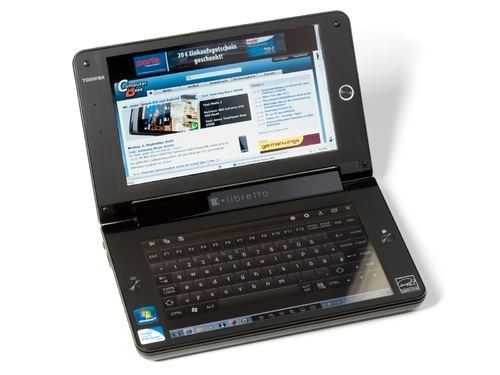
The Ultra Mobile Challenge is Harder Than Ever
Posted on 16 June 2011
Let’s say you need a UMPC. It’s not as uncommon as some people think. It might not be the consumers cup of tea but in industry, mobility counts for a lot. Logistics, amateur pilots, health industry, blue-light industry, traveling geeks and other situations where full capability, compatibility and flexibility in the smallest package is key. The problem is, if you need a ultra mobile PC today, what the hell are you going to buy?
Lets put down a little wish-list for the sake of the argument.
Sub-1KG, Windows 7 support, 5hrs battery life 5-8.9 inch screen, easy conversion to keyboard/screen device. Price under $1000.
The shortlist I would recommend right now would be the following but they are all ‘last-gen’ UMPCs, at least a year old and going out of stock, and probably entering the end-of-life phase.
- Fujitsu UH900
- Sony Vaio P
- Viliv N5
- Viliv S7
- Viliv X70
- Archos 9 (with SSD, 1.2Ghz)
- UMID Mbook SE Thx to Gearsguy for the information on the availability and videos. I’ve included one of the videos below.
If you need a keyboard, the Mbook SE, UH900 and N5 are worth a look. The Archos 9 is good value at under 450 Euro right now and the X70 is a great performer. Isn’t it underwhelming that these devices are all over a year old though.
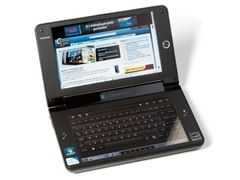 One device I took a second look at was the Toshiba Libretto W100. Originally this device was available for 1100 Euro. Today, it’s under 600 Euro in Europe making it an interesting option because of its CPU – Pentium Dual-Core U5400 with 2x 1.20GHz that comes in at about 130% the processing power of a high-end dual-core Atom part. It also includes 2048MB Ram and a 62GB SSD. This is certainly an ultra mobile workhorse but the design and battery life are going to be issues for some. 3hrs isn’t that exciting. Interestingly this could make a super ultra-mobile video editing platform.
One device I took a second look at was the Toshiba Libretto W100. Originally this device was available for 1100 Euro. Today, it’s under 600 Euro in Europe making it an interesting option because of its CPU – Pentium Dual-Core U5400 with 2x 1.20GHz that comes in at about 130% the processing power of a high-end dual-core Atom part. It also includes 2048MB Ram and a 62GB SSD. This is certainly an ultra mobile workhorse but the design and battery life are going to be issues for some. 3hrs isn’t that exciting. Interestingly this could make a super ultra-mobile video editing platform.
This dearth of options in this space is because of two things. Firstly, Menlow is out and Oaktrail isn’t yet in. There isn’t really another platform to think about right now although I’ve got my eye on AMDs Z-01 We’re going to have to wait for a set devices on Oaktrail for another few months. The other issues is the 10 inch tablet craze. It puts designs at around the 1KG mark and limits usability. The Viliv X70 is one to keep an eye out for but based on the silence from Viliv, I’m guessing it’s not close to being available yet.
Widening your choices
Netbooks, starting at about 1.2KG (2.6lb) and large-format Windows tablets (again 1.2KG when a keyboard is added) along with 5~ and 7~ Android tablets and the iPad2 all need consideration. Even the >4 inch Android phones with the latest CPUs. As Meego filters in, keep an eye on that too as it spans mobile and desktop environments. Finally, Honeycomb and WebOS are operating systems to watch. Personally I have high hopes for Honeycomb as one of the more flexible operating systems to cross-over into a productive and flexible environment and that could happen on either ARM or Intel.
Choosing a platform for 2012
Oaktrail Intel’s Z6xx series. We’ve seen it running Windows, Android and Meego already, it will run Chrome OS and there should be forward compatibility with Windows 8 making it, in my opinion, one of the most interesting ultra-mobile platforms out there right now. Intel builds of Honeycomb and Meego should be able to squeeze more battery life out of it too. There’s a 2X graphics improvement over Menlow (GMA600 vs. GMA500) and even hardware 720p video encoding which could speed up video rendering. At 1.5Ghz, it’s not the most CPU-powerful platform but Intel have already talked about 1.8Ghz versions and I’m sure, if the platform becomes popular, we could see dual-core versions too. Why Oaktrail and not Cedar Trail? Because it’s got power management capabilities that Cedar Trail hasn’t got.
Waiting for Sandy Bridge.
Sandy Bridge in ultra-low-voltage guise is very interesting. I recently tested an AMD-E350 based Lenovo S205. It was good. It’s TDP (CPU+GPU) is 18W and the CPU performance is high-end Atom level. Sandy bridge, on the other had also comes in 17W TDP variants but the CPU performance on these simply blows Atom, E-Series Fusion and even first-gen Core parts out of the water. with around 5x the CPU performance of an Atom CPU along with some good GPU performance. Price is high as we’ve seen with the Samsung Series 9 but that devices comes in at 1.3KG with 6hrs of battery life and serious compute power. It’s a sign that Ultrabooks could push down in to even smaller and lighter designs.
My plan. What’s yours?
Today I sold my last netbook / laptop. Over the last few months I’ve been having a clear-out and now I’m left completely without any sort of mobile productivity device. It’s a nice position to be in but it’s going to be a tough decision. Right now I’m favouring the Samsung TX100 / Gloria / PC7 Slider on Oaktrail because I’m interested in Oaktrail performance and multi-OS scenarios. I’m worried about the CPU performance though. I’m also looking carefully at that Toshiba W100/W105 show above. I think I can run PowerDirector video editing suite on that and get some usable 720p rendering speeds that should be 2x what the Oaktrail platform can produce. Finally, Samsung have another very interesting product in the Series 9 laptop on Core i5 Sandy Bridge. It’s an expensive item but a real mobile workhorse. And why am I looking at all these laptop-style devices? Because after spending 7 months with the Galaxy Tab I’ve found that there are fewer things I need to do on a laptop now and those things generally involve high-productivity working with Video, Images and multiple windows. The 7 inch tablet has filled a great position but along with my new requirement to product 720p videos, has pushed up my requirements for a laptop.
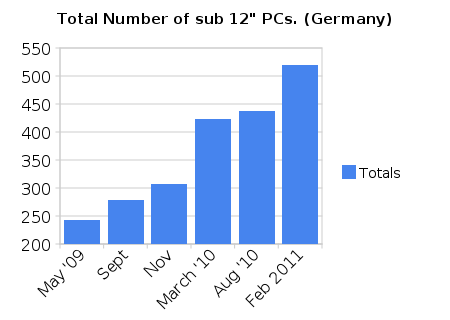
Screen Size Analysis (Sub 12″) Feb 2011
Posted on 09 February 2011
This is the sixth report on sizing trends in PCs below 12 inch screen size (and above 5 inch) appearing in the German market through the popular price comparison engine, Geizhals.at (*1) The last one was done in August 2010 In this report you’ll see a big jump in overall numbers, a reversing of the decline in 7 inch devices and a turnaround in the 10 inch segment.
Number of SKUs in the market.
Screen size distribution
The big jump in numbers is clear to see from the top graph. Total numbers jumped by 83 and this is likely to be due to the Christmas season and introduction of new model ranges following IFA 2010. Surprisingly, the 10 inch segment has grown in numbers and %. A lot of this is attributable to dual-core Atom N550 devices.
- Over 20 Intel Atom N550 devices appeared exclusively in the 10 inch category.
- 62% of the devices are running on Intel Atom. One year ago, this figure was 78% Remember that the segment includes some devices running laptop-grade CPUs and there’s an influx of AMD and ARM devices in the top and bottom end of the 5-11 inch range. This is not just an analysis of ‘netbooks.’
- The 7% segment had the biggest percentage growth (over 300%, from a very low starting point) and the 10% segment had the biggest numeric growth (63)
- Including Android, over 14% of the segment runs a Linux kernel. One year ago this figure was 5%. Almost all of this growth is within the ‘tablet’ style of devices.
- Only 13% of the devices weigh 1KG or less. (up from 10% one year ago again, growth is in the tablet segment)
- 18 devices now include Nvidia ION2. All of these are from a single manufacturer – ASUS.
- Total number of tablet form-factor devices 60 (not including 4.8 inch) which is about 10% of the total sub 12% screen size market.
The cheapest devices (based on lowest price offered) are:
- X86/Windows Laptop Samsung N145 at 228 Euro
- ARM Tablet Nexoc Pad 7 (Android 1.5) at 99 Euro
- X86/Windows Tablet Archos 9 at 402 Euros.
Also of note is the larger spread of GPU technologies, the increased us of SSDs (even in the X86/Windows segments) and a large number of dual-core CPUs. Dual core CPUs make up a 30% of the 10-11.6 inch bracket now.
In the last report I talked about a netbook freeze. Certainly the trends for search and news seem to be heading south (see below for ‘netbook’ trend) but the increase in numbers of 10 inch devices indicates that there is still interest from manufacturers. The increase in SKU’s, however, could be misleading as we’re seeing an increase in the number of colour options, CPU options, GPU options and screen options that use the same chassis. Acer and ASUS each have over 90 different model types in the German market in the 10-11.6 inch category.
I think most people in the netbook field would agree we’re seeing a levelling of interest and manufacturers are using offers and personalisation to attract sales in this mainstream part of the segment lifecycle.
For mobility fans though the message is clear. There are more options than ever and competition is increasing which will drive improvements in software and hardware very quickly. Certainly we will see the tablet segment grow and it will be interesting to see how the 5-9 inch segments move when we do the next analysis in about 3 months time.
Warning: Please remember that this is a single data-source analysis of what is happenning today, in the German market. This is not a complete market analysis report. You may use the data and images but please also reference this article which includes this warning.
*1 Based on SKUs, not model families. Note that Geizhals have now moved all tablets to a new category called ‘tablets.’ This category was included in the analysis. An English language (and UK market) version of Geizhals is available at Skinflint.
 |
| |||
 |
| |||
 |
| |||
 |
| |||
 |
| |||
 |
| |||
 |
| |||
 |
| |||
 |
| |||
 |
|

